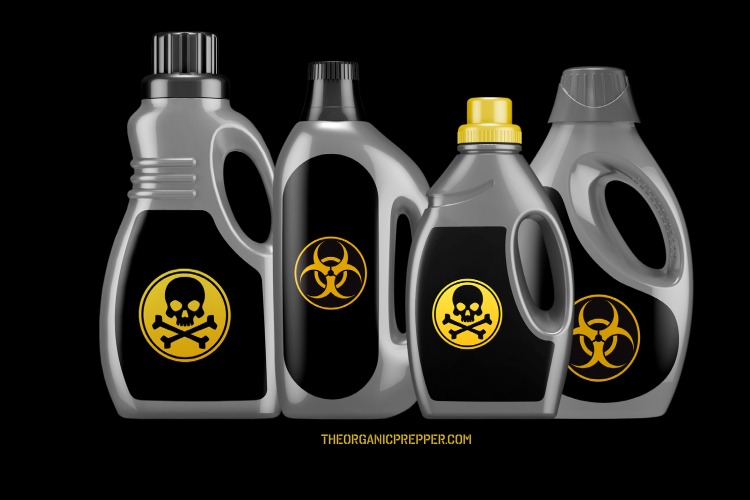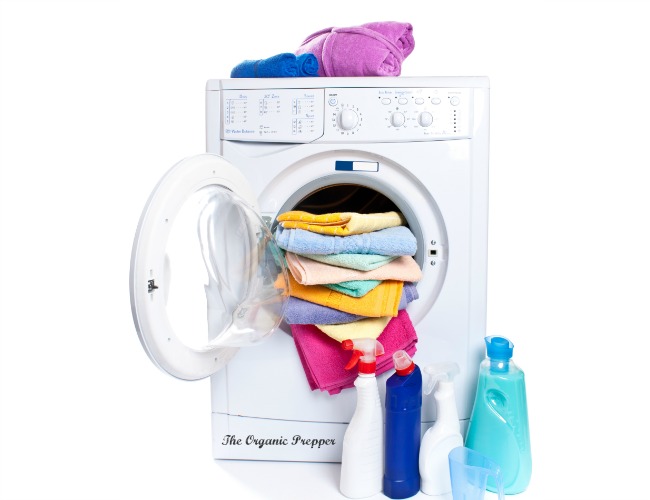If you're new here, you may want to subscribe to my RSS feed. Thanks for visiting!
by Daisy Luther
For a space that’s completely dedicated to getting things clean, the laundry room can be a landmine of dirty substances. Toxic laundry products can contain ingredients that are irritating to the skin and damaging to the lungs. Some products disrupt hormones and have been linked to cancer.
This month, our Whole Home Detox efforts focus on the laundry room. We’ll discuss laundry detergent, fabric softener, and dryer sheets. There are homemade options that are excellent, or, if you aren’t into DIY, I’ll list some products you can buy that are less of a threat to your health than the standard offerings at the store.
What’s in your laundry room?
The detergent aisle at the store is a bright colorful place full of enticing promises.
- Gets Clothes Cleaner!
- Brightens Whites!
- Outdoor Fresh Smell!
- Removes Stains!
And you know, those promises are the whole point of doing laundry. We want our end result to be clothing that is stain-free, clean, and fresh smelling. But the route to this goal can be fraught with hazards these days, because there is no real oversight regarding the ingredients in the soaps you get at the store.
The substances contained within laundry products aren’t that bad if you are just exposed to them once, but when you use them in your laundry, you have constant exposure. The artificial fragrances are chemically designed to linger in your clothing, meaning that your skin and lungs are constantly exposed. These fragrances and other toxic ingredients build up over time in your system and have been linked to issues like:
- Asthma and other respiratory issues
- Hormone disruption
- Reproductive problems
- Birth defects
- Cancer
- Liver and kidney damage
Manufacturers aren’t required to list the specific ingredients of their products
Manufacturers trade secrets are protected before our health is. This increases the difficulty for consumers who are trying to make informed decisions about the products they use for their families.
Back in 1976, the Toxic Substances Control Act was passed, but only a few chemicals used in commerce have been subjected to testing. Of the ones that have been tested, even fewer have been tested in combination with the other chemicals that are in the detergents. (Often a substance that is perfectly harmless on its own can become extremely dangerous when combined with another chemical.) Some have been proven to be toxic in animal studies, but no testing has been done to see how those substances are potential dangerous to humans. Still others have been shown to be harmful to human health, but they’re used nonetheless. Don’t look to the EPA or the FDA for help on this one. They’re more interested in going after small businesses like artisan soapmakers and women who sew cloth solutions for feminine hygiene. Meanwhile, large corporations continue to poison us, completely unchecked.
The 8 Worst Ingredients in Toxic Laundry Products
The bottom line: it’s totally up to you to keep the following chemicals out of your home. In no particular order of awfulness, these are the 8 worst ingredients you are likely to find in the laundry aisle:
- 2-Butoxyethanol: This is in stain remover, as well as an ingredient in dry cleaning products. It has been linked to birth defects, reproductive issues, developmental delays, blood issues, upper respiratory issues, and digestive issues. The substance is irritating to the eyes, the skin and the respiratory tract and is a known animal carcinogen. Tests have not confirmed carcinogenic effects on humans. Rated F by the EWG.
- Artificial fragrances: These can run the gamut, since “artificial fragrances” is such a broad term. Skin, lung, and eye irritation are of immediate concern. Some have been linked to cancer. Fragrance can be a trigger for migraines, allergies, and asthma for some people.
- Chlorine: This is the primary ingredient in bleach. It’s a strong irritant for the eyes, upper respiratory tract, lungs, and skin. It has been linked to cancer and reproductive concerns. “Chronic (long-term) exposure to chlorine gas in workers has resulted in respiratory effects, including eye and throat irritation and airflow obstruction.” (NIH) Rated F by the EWG.
- Diethanolamine: This is an ingredient found in many detergents. “Limited information is available on the health effects of diethanolamine. Acute (short-term) inhalation exposure to diethanolamine in humans may result in irritation of the nose and throat, and dermal exposure may irritate the skin. No information is available on the chronic (long-term), reproductive, developmental, or carcinogenic effects of diethanolamine in humans. Animal studies have reported effects on the liver, kidney, blood, and central nervous system (CNS) from chronic oral exposure to diethanolamine. The National Toxicology Program (NTP) reported an increased incidence of liver and kidney tumors in mice from dermal exposure to diethanolamine.” (NIH) Rated F by the EWG
- Ethyl acetate (Also ethoxyethanol acetate and related to ethylenediaminetetraacetic acid) This is an ingredient in fabric softeners. Prolonged inhalation may be damaging to lungs, liver, kidneys, & heart. “Runners were evaluated after complaining of wheezing coughing, rhinitis, or shortness of breath after practicing in a facility under construction. Investigation revealed levels of ethyl acetate and toluene low enough to meet federal guidelines but apparently sufficient to cause symptoms in the athletes.” (NIH) There is a high concern for developmental and reproductive toxicity. Rated F by the EWG
- Optical Brighteners (also listed as ER, KSN, OB, OB-1 ) Optical brighteners are a variety of different chemicals that coat clothing in the washing machine and stick to the fabric even after rinsing, to make the washed item appear brighter. Optical brighteners can cause skin irritation and have been linked to reproductive and developmental issues.
- Petroleum distillates (also called naphtha) These chemicals are frequently found in laundry detergent. They have been linked to linked to cancer and lung damage. There is some evidence of DNA damage. Rated F by the EWG.
- Quaternium-15: This chemical found in laundry detergent releases formaldehyde, which is a known carcinogen. It can trigger asthma, damage the respiratory system, and cause skin rashes upon contact. Rated F by the EWG
So will these ingredients immediately cause toxicity and death?
Nope. They may not even cause symptoms of illness right away unless you’re incredibly sensitive to that type of thing.
For most of us, the issue is not occasional exposure, but cumulative exposure. If these substances are indicated as causes of illness and disease, isn’t it better to avoid them whenever you can? While you can’t stay away from these types of substances when you are out and about, what you choose to bring into your home is completely under your control. So why not avoid exposure whenever possible?
How to avoid toxic laundry products
There are some great resources available to help you avoid the hazards listed above. This month in our Whole Home Detox, we’ll break down our laundry room into the following categories. Below, I’ll add the links as the articles are written.
- Laundry detergents
- Fabric softeners
- Dryer sheets
Homemade products are nearly always my favorite because then you know exactly what’s in them. (And they’re very budget-friendly!) However, if you don’t like DIY, don’t worry! There are some good products out there that you can purchase to replace the standards that contain ingredients you don’t want to bring into your home.
Stay tuned for detailed instructions and recommendations to replace the toxic products with less harmful alternatives.
Sources:
EWG’s Guide to Laundry Products
Resources
What You Don’t Know Can Hurt You
Natural Laundry Detergent: DIY Organic Laundry Detergent Recipes For Effective Cleaning
Better options for laundry products
Check Out the Other Articles in the Whole Home Detox Series
- The Healthy Baker’s Shopping Guide to Non-Toxic Ovenware
- The Healthy Cookware Shopping Guide (and What to Avoid)
- Home Detox: How to Rid Your Environment of the Sources of Chronic Illness
- Are These Dirty Little Secrets Lurking in Your Toxic Laundry Products?
- The 10 Safest Laundry Detergents (And Brands to Avoid)
- The Safest Dryer Sheets and Fabric Softeners (and the ones to avoid)

















3 Responses
Daisy,
Thank you for writing this. I think it is shameful that our government has ALLOWED these chemicals to be in our laundry cleaners.
Traces of these toxins remain on our clothing and are absorbed into our bodies through our nose, mouth, and skin.
Even baby bath products contain all kinds of chemicals.
Daisy, I read your article on laundry detergent and toxins and wanted to tell you about a product I purchased three years ago called Pure Wash. It is essentially a small box that hangs on the wall above my washer. The cold water hose is hooked to itl and when I turn the washer on the water is run through a light which kills bacteria and then moves on to the second part which breaks the water down into hydrogen and oxygen. In essence its peroxide when it goes into the washer and recombines into purifed water while washing the clothes. You use NO detergent or fabric softeners. You also use no hot water. I have been using this product for three years and its awesome. The first few times I caught the water as it came out of the machine in its spin cycle. It was disgusting! And smelled really bad. It was the detergent and body oils that had accumulated in the fabrics over time and time again of being washed in these chemical solutions. Now my clothes smell Clean not chemically and they wear better as a result. I also have no dryer but hang them outside to day. Would never go back. I’m sure if the Pure wash is googled it can be ordered online. I got mine from the applicance store where I bought my washer.
Very nice dryer balls
http://prepforshtf.com/diy-wool-dryer-balls/#.VpzeIq88KrU